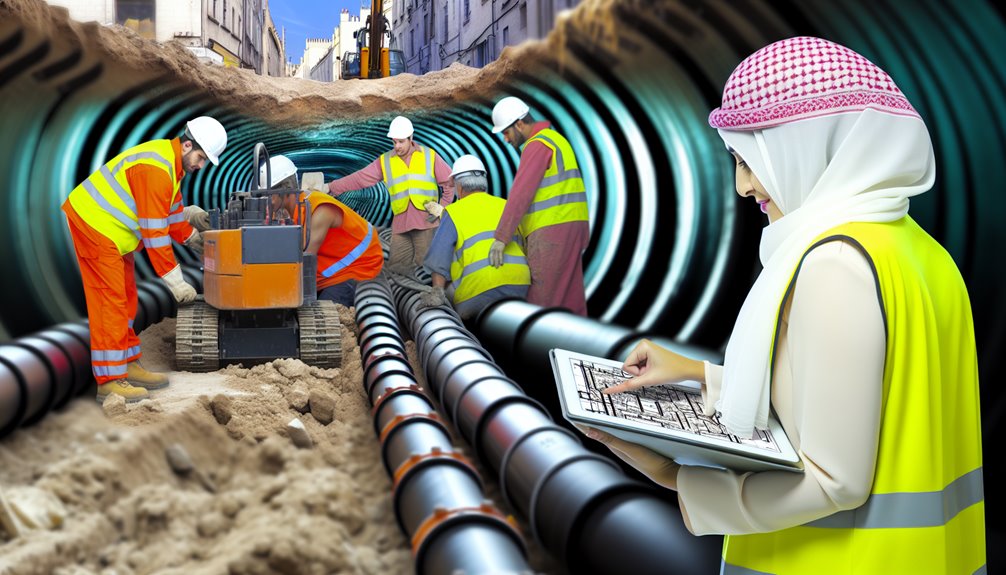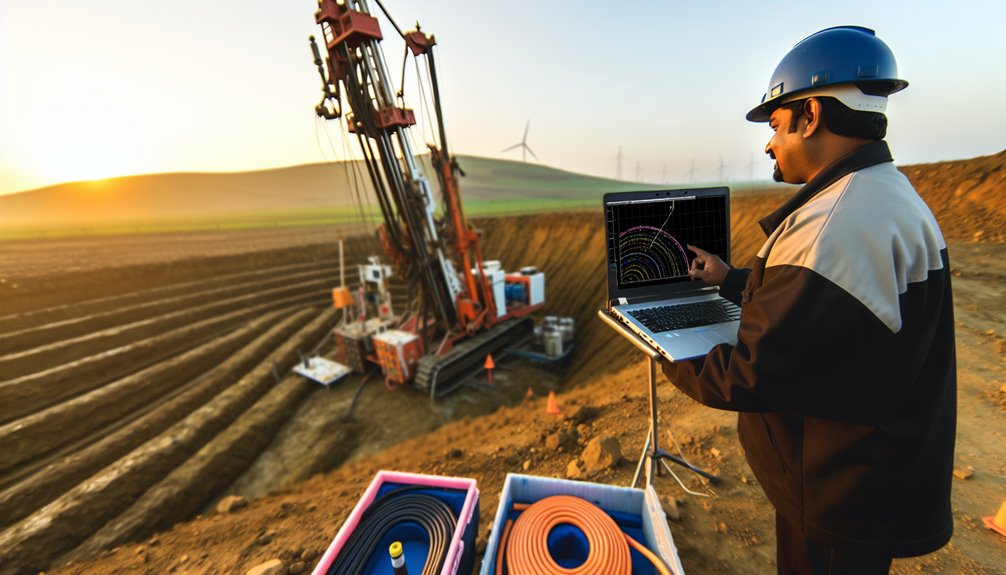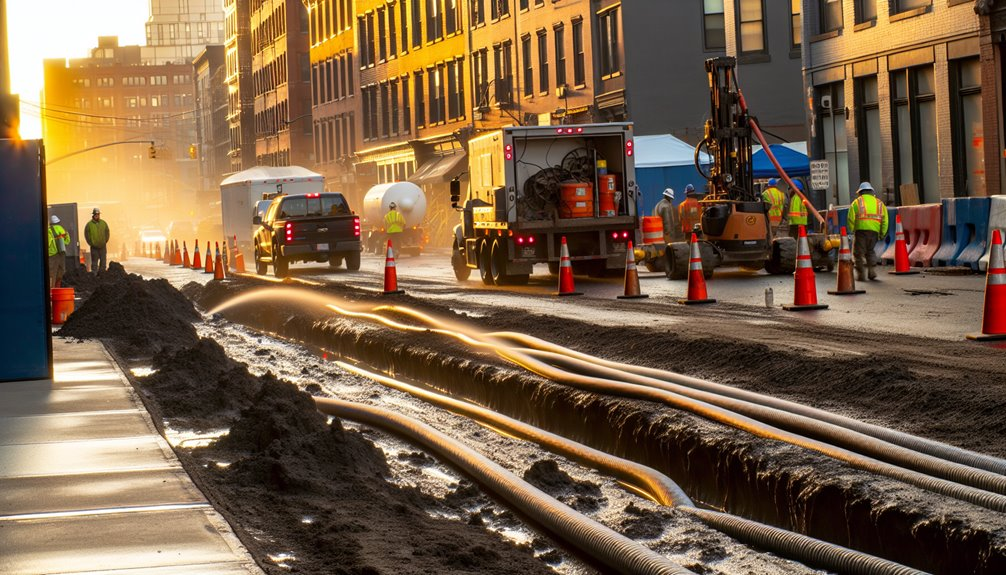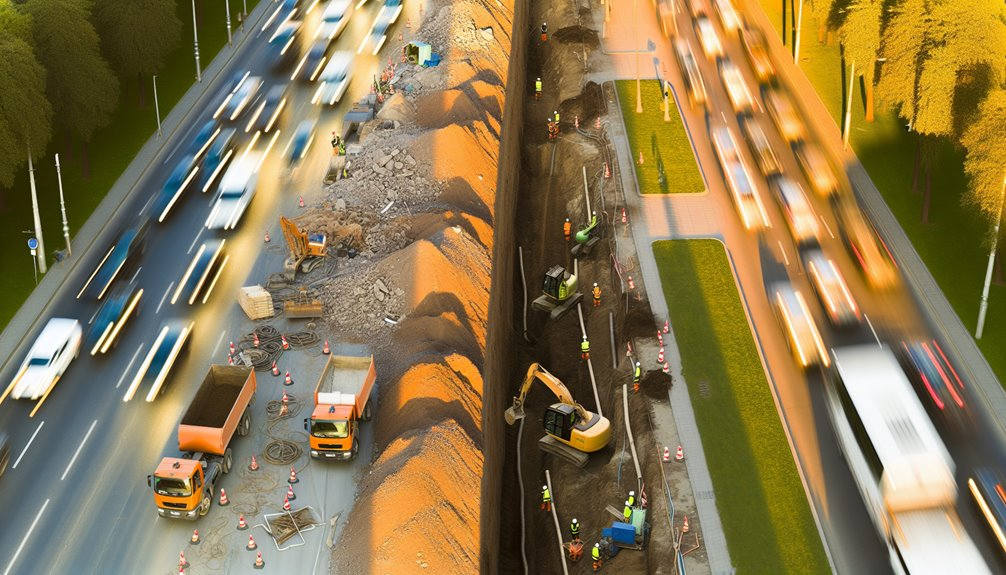In traversing the complexities of underground utility construction, you'll discover that the initial phase of accurately mapping existing utilities is essential. Utilizing Ground-Penetrating Radar (GPR) not only enhances detection precision but also integrates seamlessly with Geographic Information Systems (GIS) to offer a detailed subsurface view. This integration not only mitigates risk but also greatly trims down unexpected costs related to project delays and design alterations. As you explore further, you'll find how early stakeholder engagement complements this technology in driving efficiency.
Early and Detailed Project Planning
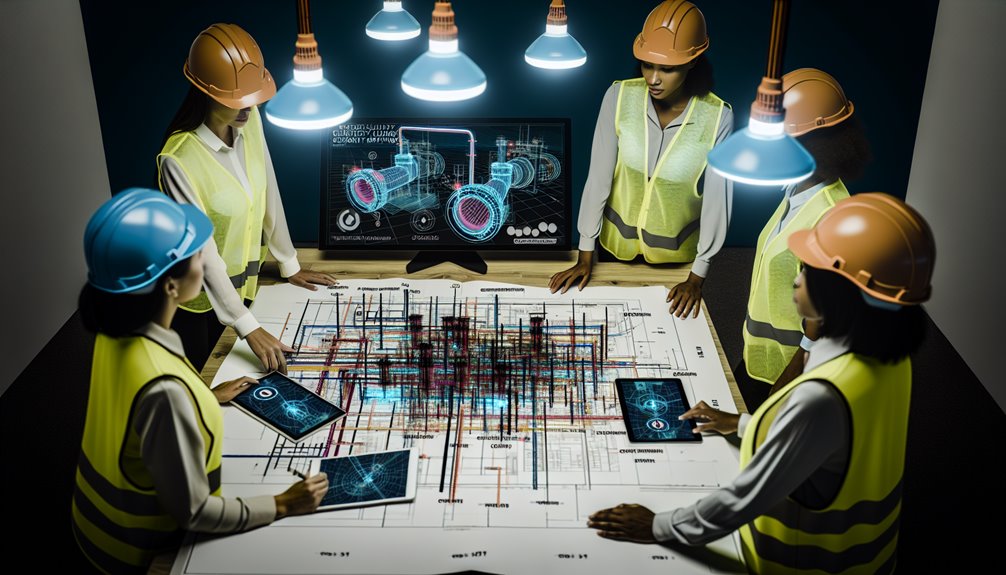
To maximize efficiency and minimize costs in underground utility construction, it's vital to engage in early and detailed project planning. You'll need to collaborate closely with designers to guarantee utility placements are accurately modeled and routed, considering site-specific considerations. Early involvement of utility stakeholders is essential; inform them about construction schemes and solicit their input to gather important data. This proactive engagement helps in identifying major utility features that might impact your project, allowing for the development of tailored strategies to mitigate potential challenges. Implementing effective communication protocols is imperative to keep all parties updated, assuring alignment and facilitating the smooth execution of your project plan, while diligently preparing and negotiating all necessary documentation to preempt conflicts. Additionally, employing advanced technologies like ground-penetrating radar can significantly enhance the accuracy of underground utility mapping, ensuring fewer disruptions during construction.
Utilizing Advanced Ground-Penetrating Technologies
As you explore advanced ground-penetrating technologies, consider the considerable benefits of Ground-Penetrating Radar (GPR). This technology not only enhances the detection of various underground materials but also contributes greatly to cost efficiency by minimizing the risk of utility damage. Detailed analysis reveals that integrating GPR in your projects can lead to more precise excavation planning and resource allocation, thereby optimizing construction timelines and reducing unexpected expenses. Furthermore, the integration of GPR technology helps in accurately locating underground utilities, which is crucial for avoiding disruptions in water, gas, and communication services.
Ground-Penetrating Radar Benefits
Utilizing advanced ground-penetrating radar (GPR) technologies offers considerable benefits in underground utility construction, especially regarding accuracy, cost-effectiveness, efficiency, and environmental safety.
GPR technology excels in underground mapping, providing a 97% accuracy rate in locating both metallic and non-metallic utilities up to 13 feet deep. This precision not only enhances planning but also minimizes costly disruptions by preventing utility damage.
The speed and non-invasive nature of GPR surveys streamline data acquisition, offering real-time, high-resolution images that expedite decision-making without disturbing the site.
Moreover, it's a cost-effective solution, greatly reducing potential expenses linked to utility repair and unnecessary excavation.
GPR's role in enhancing safety by preventing accidents and environmental harm can't be overstated, making it an indispensable tool in modern construction practices.
Enhanced Detection Techniques
Building on the foundational benefits of ground-penetrating radar outlined previously, we now explore enhanced detection techniques that leverage advanced GPR technologies.
You'll find that the integration of multi-channel devices and varying wave frequencies markedly boosts your utility mapping accuracy. These tools not only detect a wide array of material types—from PVC to concrete—but also provide precise depth measurements.
The versatility of GPR extends to identifying non-utility subsurface anomalies like voids or old infrastructure, vital for thorough site analysis.
Moreover, technology integration with Geographic Information System (GIS) transforms raw GPR data into actionable 3D visualizations.
This seamless melding of GPR and GIS guarantees you're equipped with detailed, real-time subsurface maps, streamlining project workflows and decision-making processes.
Cost Efficiency Analysis
While advanced ground-penetrating radar (GPR) technologies dramatically enhance subsurface mapping, they also introduce significant cost efficiencies throughout the construction process.
You'll find that GPR's precision in detecting underground utilities enables more accurate cost estimation earlier in your projects. This accuracy mitigates the risk of costly delays and utility relocations, streamlining utility coordination and reducing the need for extensive rework.
Implementing Subsurface Utility Engineering (SUE) with GPR data not only reduces the incidence of unexpected utility hits but also lowers overall project expenditures by 10% to 15%.
Additionally, GPR's ability to uncover previously undetected objects guarantees thorough mapping, minimizing change orders and enhancing project safety, which in turn, protects your budget against unforeseen costs.
Optimizing Material Selection and Procurement

To optimize material selection and procurement in underground utility construction, it's essential to evaluate both the physical properties of materials and the strategic aspects of sourcing them.
You'll need to conduct thorough material testing to understand how regional variations in concrete and soil affect thermal resistivity, vital for ensuring the efficiency of underground cable systems. Accurate testing guides your selection, impacting project sustainability and cost-effectiveness.
Simultaneously, prioritize supplier evaluation to enhance procurement strategies. Early supplier involvement and market analysis empower you to forecast needs accurately, negotiate better terms, and purchase in bulk—key actions that mitigate risks and control costs.
Building strategic, long-term supplier relationships further solidifies your supply chain, ensuring timely delivery and consistent material quality.
Implementing Efficient Workforce Management Practices
Implementing efficient workforce management practices is essential for enhancing productivity and reducing costs in underground utility construction.
By investing in advanced time management systems and optimizing workday planning, you'll minimize downtime and boost worker productivity.
Utilize mobile workforce management tools, enabling real-time data access to streamline labor allocation and monitor workforce availability meticulously. This approach not only mitigates labor shortages but also guarantees skilled labor is deployed where most needed, enhancing operational efficiency.
Embrace digital tools for dynamic workforce training, ensuring all team members are adept with the latest technologies and procedures.
This strategic focus on workforce training and precise labor allocation will markedly trim costs and elevate project execution standards.
Adopting Trenchless Construction Techniques
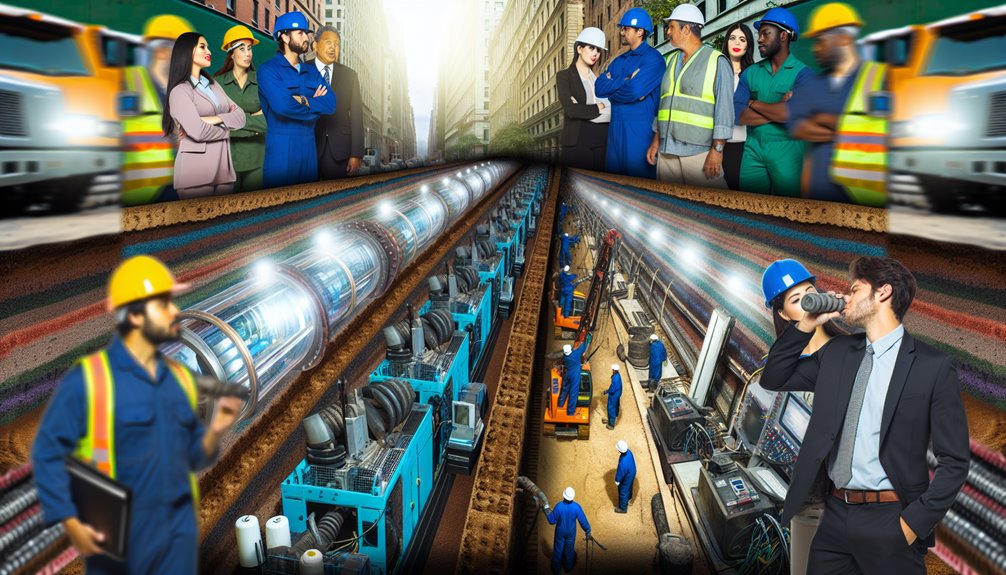
You'll find that adopting trenchless construction techniques offers significant cost savings and minimizes disruption when compared to traditional open trench methods.
By analyzing the variance in savings across different surface types, from normal soil to interlocking tile roads, it's evident that trenchless methods can reduce both direct and indirect costs by 15% to 73%.
Additionally, these technologies drastically cut traffic delay costs and enhance project efficiency, making them a superior choice for urban and sensitive environmental areas.
Benefits of Trenchless Methods
Adopting trenchless construction techniques offers considerable cost savings and efficiency gains in underground utility projects.
You'll appreciate the trenchless advantages, including reduced material usage due to the elimination of continuous trenches, which drastically cuts direct costs for pipe replacement—achieving savings from 80% to 95% depending on the pipe size.
Additionally, the environmental benefits are profound. This method minimizes disruption to existing ecosystems and infrastructure, particularly crucial near sensitive water bodies.
By avoiding extensive excavation, trenchless methods not only preserve natural habitats but also contribute to sustainable infrastructure development by markedly reducing the overall environmental footprint.
Furthermore, the reduced surface restoration needs post-project completion further underscore its cost-efficiency and minimal ecological impact.
Comparing Traditional vs. Trenchless
While trenchless construction techniques are gaining popularity for their efficiency and lower environmental impact, it's critical to compare them directly with traditional excavation methods to fully appreciate their advantages.
You'll find that traditional methods, while established, have significant drawbacks. They're more time-consuming and costly due to extensive site restoration needs. Additionally, the environmental disruption and high labor intensity add to their overall expense.
In contrast, trenchless technology benefits are compelling. This method significantly reduces material and labor costs, minimizes social and environmental impacts, and aligns better with regulatory compliance.
Specifically, adopting trenchless techniques could save you up to 106.3% in costs compared to traditional methods, making it an innovative and financially sound choice for your next project.
Streamlining Communication and Documentation
To enhance efficiency in underground utility construction, streamlining communication and documentation processes is critical. You must define a clear chain of command and implement regular check-ins.
Utilize real-time communication tools to align office and field teams efficiently. Establish open channels for effective feedback, fostering a culture where communication barriers are minimized. Make certain that project goals and deadlines are communicated clearly through daily briefings or digital updates.
Choose the right communication method—email for simple updates and face-to-face discussions for complex issues. Active listening and the use of visual aids like annotated blueprints and 3-D models will clarify objectives and reduce misunderstandings.
Finally, streamline documentation by using digital tools and maintaining a single source of truth to make certain all team members have quick access to accurate information.
Leveraging Project Management Software
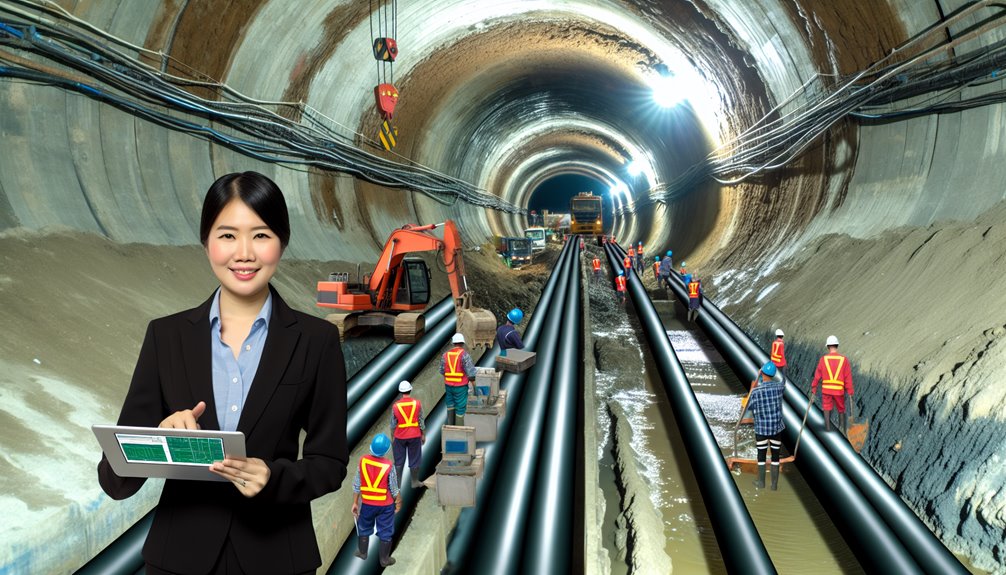
Building on streamlined communication and documentation, effectively leveraging project management software becomes the next step to enhance operational efficiency in underground utility construction.
You'll find that advanced project management tools aren't just about tracking; they're about optimizing resource allocation. By utilizing real-time tracking capabilities, you guarantee that labor and materials are deployed efficiently. This approach minimizes waste through Just-in-Time delivery strategies and maximizes productivity by cross-training your workforce.
Additionally, electronic time cards integrated into these systems facilitate precise monitoring of operations directly from your mobile device. These tools collectively refine your resource management processes, guaranteeing that every aspect of the project aligns with both budgetary constraints and timeline expectations, thereby safeguarding your bottom line.
Conducting Thorough Risk Assessments
Before initiating any underground utility construction project, conducting thorough risk assessments is essential to identify and mitigate potential hazards effectively.
Utilize advanced technologies like Ground Penetrating Radar (GPR) and private utility locating services to pinpoint underground risks early, preventing accidents and project delays.
Employ risk assessment matrices and models, integrating both qualitative and quantitative analyses to assign numerical risk scores. This systematic approach guarantees effective risk prioritization, allowing you to focus resources on mitigating high-level risks first.
Engage stakeholders by sharing risk assessment outcomes and incorporating their insights into developing risk management strategies. This stakeholder engagement fosters informed decision-making and enhances the adaptability of your risk management plans throughout the project lifecycle.
Emphasizing Preventive and Predictive Maintenance
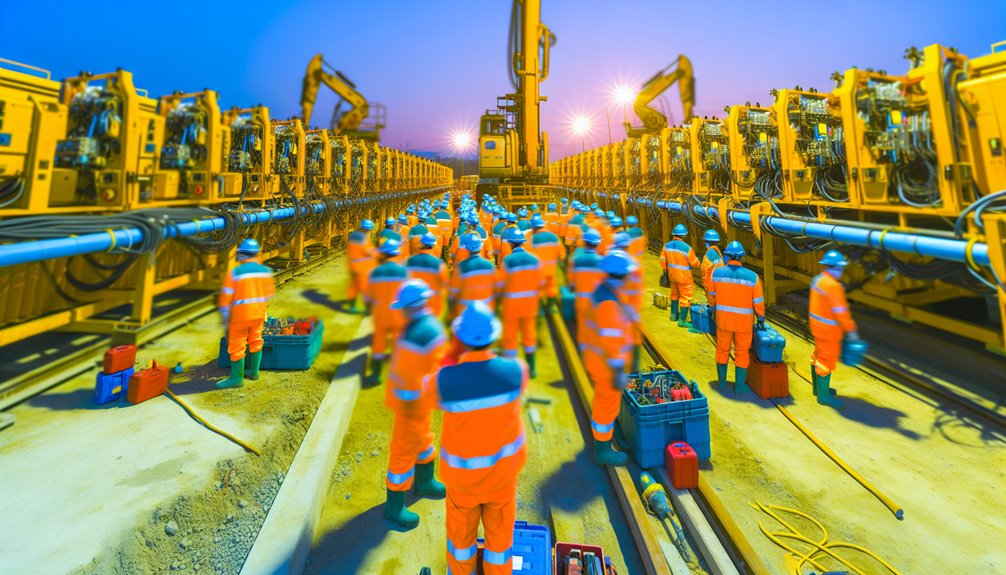
After identifying and mitigating risks through thorough assessments, focus shifts to maintaining the longevity and reliability of your underground utility infrastructure.
By leveraging predictive analytics, you can optimize maintenance scheduling and drastically reduce system downtime. Here's how you should approach it:
- Utilize predictive models to forecast potential failures, prioritizing proactive maintenance.
- Integrate GIS and LiDAR data for a detailed view of network health, enhancing predictive accuracy.
- Monitor critical components continuously to identify issues before they lead to costly breakdowns.
- Apply machine learning algorithms to sensor data for advanced degradation pattern recognition and failure prediction.
- Streamline maintenance scheduling using Big Data platforms to efficiently allocate resources and prevent unplanned outages.
Conclusion
As you finalize your underground utility construction project, guarantee you've utilized GPR integrated with GIS for precise planning and minimized change orders. Engaging stakeholders early optimizes resource allocation and reduces rework. Adopting trenchless techniques and leveraging project management software streamline operations and enhance communication. Always conduct thorough risk assessments and emphasize preventive maintenance to avoid future costs. These strategies are essential for maintaining budget control and achieving project efficiency in the complex environment of underground utility construction.
If you're interested in learning more about how to enhance your underground utility projects, I invite you to visit Boring Bros at boringbro.com or give us a call at (954) 639-6167. We would love to help you discover innovative solutions and strategies tailored to your specific needs. Let's work together to make your project a success!

